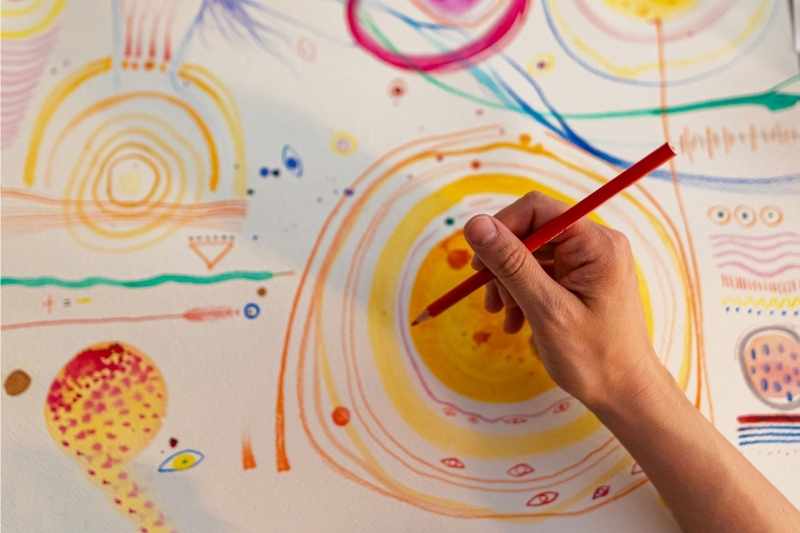Often the word grief can conjure up images of despair, death, and withdrawal from the world. However, grief is an emotion that can extend throughout various stages of life, not just at the death of a loved one.
Childhood trauma brings with it a very unique set of losses. In our adult years, the unnamed losses of developmental trauma can resurface unexpectedly. This might be through flashbacks or replaying of childhood memories and stories. This can feel like a never ending struggle to keep everything together as the life you wish and hoped for slips away.
In this blog post I’ll share with you the different forms of grief, and why experiencing grief might be a sign that you are beginning to heal from childhood or developmental trauma.
How Trauma Creates Loss
Grief can be overwhelming feelings of sadness and sorrow that accompany a specific loss, like the death of a loved one. However, some grief is more fluid and difficult to define.

For those who have endured childhood trauma, grief has its own unique flavour. This is a grief that may not always be felt in the moment, but can lurk in the shadowy recesses of our mind until the appropriate time. It is the result of circumstances that we could not make sense of on our own as children. This can include the cumulative effects of bullying, violence, emotional instability, persistent conflict, corporeal punishment, or lack of emotional availability by one or more caregivers (often due to their own intergenerational trauma).
Trauma in childhood robs us of the life we wish we had. It robs us of the relative safety that others are afforded. With that fracturing of spirit comes a different set of losses:
- Loss of safety: This can include physical safety – for example in the case of sexual abuse no longer feeling safe within your own body. This can also include emotional safety – such as feeling anxious and unsafe to experience and be supported in the full intensity of your emotions, such as sadness or anger. This communication from your environment that you are unsafe to experience your emotions can come in direct forms, such as being yelled at or hit for expressing emotions, or the more covert forms, such as being shamed, blamed, labelled, or told you are creating problems for your caregivers or community by expressing emotions. These messages that it isn’t safe to feel emotions can become internalized in the body and mind, leading to anxiety, panic attacks, and physical symptoms such as digestive issues, chronic pain, or chronic inflammation in later years.
- Loss of love and attachment: for survivors of childhood trauma, there can be a profound experience of grief for the loss of the love you wish you had. For example, adult children with divorced parents often carry deep seated feelings of grief and shame over the loss or withdrawal of affection. This can fester as a deep belief that somehow, you weren’t enough to keep your parents together, even though logically you may know that’s not true. Similarly, children who were shamed or abused often internalize a message that somehow they weren’t “enough” to stop the abuse from happening. In later years, this can affect the ability to get close and build meaningful relationships.
- Loss of hopes and dreams: as children we harbour many secret inner hopes and dreams. Supportive environments provide opportunities to grow into the hopes we wish for, and grieve the losses that come with the hopes we can’t materialize.. However, for those with childhood trauma, in later years the losses of poverty, illness, injury, war, relationships, can re-open the wounds of childhood, and cause a resurfacing of grief for the unfulfilled hopes and dreams that could never be spoken. A common experience for survivors of childhood trauma is to come into therapy in their late 20s or mid 40s when they begin to reflect on the loss of hopes and dreams. Commonly called the quarter-life or mid-life crisis, this is a time which re-opens the grief of childhood loss. At this time, you may begin to realize that your life didn’t turn out the way you had secretly hoped it would.
- Loss of self: growing up with childhood trauma means constantly having to fit yourself into the expectations of others to avoid shame, abuse, criticism, or to maintain peace and harmony. This is especially the case when a caregiver is manipulative, abusive, emotionally unpredictable, or withdraws love and affection for not complying with their wishes. The result is a profound loss of self, as it requires splitting off any emotions, interests, or behaviours that you think will be a threat to receiving the basic care you required as as child. This leads to feelings of shame, and a desire to hide aspects of yourself which you might believe could be seen as bad. You may even internalize narratives about what your skills or strengths are, which inhibit you from the full expression of self.
- Inability to have closure: the person or people who caused the trauma might be deceased, or might still be alive, but emotionally unavailable, unstable, or unwilling to give you the closure you feel you deserve. The result can be an open-ended grief, or ambiguous grief, that asks to be mourned without having a definitive form of closure.
Trauma can include many more unnamed losses. These losses can interrelate, and it is rare that surviving childhood trauma would entail only one of these losses. However, the important thing to acknowledge is that losses have occurred, and grief is almost always a step in the trauma healing journey.
Grief Says You Are Beginning to Mourn
So why might grief be a sign that you are beginning to heal from childhood trauma?
Grief can be a sign that you are finally safe enough to mourn.
All grief requires a period of mourning the losses we’ve experienced. While this can be incredibly painful, beginning to mourn these losses is a pathway to healing. Grief itself is the intense feelings that happen on the inside when you experience any form of loss. This can include feeling:
- shock and disbelief
- anxiety
- fear
- anger
- loneliness
- relief
- confusion
- longing
- hopelessness
- numbness
- fatigue

Grief can also be accompanied by physical symptoms including:
- exhaustion and fatigue
- changes to sleep patterns, including sleeping too much or being unable to sleep
- appetite changes, including loss of appetite or overeating
- bodily aches and pains
headaches - tightness and clenching in the chest, throat, and abdomen
- weakened immune responses
Mourning, however, is the outward expression of your grief. It’s what happens when we accept the grief we are experiencing, and are supported enough to express the complex tangle of grief outwardly, so that it’s threads might begin to unravel.
Though most of us experience the pain of enduring a loss, to heal we must also mourn that loss. Mourning allows us to give outward expression to our inner world. Mourning allows us to integrate the loss into our lives, not just by grieving silently and inwardly (which has its time and place), but also by acknowledging outwardly what we have lost, and accepting the losses of our lives which have profoundly shaped us. In turn, that knotted bundle of grief begins to reveal new threads of life.
However, the process of mourning can be stifled or blocked if we are not in an environment that is safe and supportive enough. To mourn, we need to be allowed and supported in feeling the full range and complexity of our emotions surrounding the grief.
In some cultures, there can be a discomfort with outward expressions of grief. Friends, family, and colleagues might not always be understanding or compassionate towards our emotional expressions of grief. And we may internalize feelings of shame that we are experiencing grief.
Many of my clients are high-achieving professionals, and end up in workplace cultures that can explicitly and implicitly encourage no showing “signs of weakness”. This can be compounded by a culture that deprioritizes grieving and values strength and hard work – for example, bereavement laws or workplace leave policies may only allow 2 weeks off at the death of a loved one. In a sense, we can get rewarded for zipping up the grief and tucking it away, which brings a form of surface level intimacy. We get acceptance for showing only the pretty parts, and for being remarkably good and suppressing our true selves.
Mourning is a profoundly courageous act of strength. In the case of mourning the losses of childhood trauma, it takes courage to allow ourselves to trust someone else enough to show them our most hurt and vulnerable parts. The parts that carry the sadness and grief of loss. Mourning allows us to get in touch with all parts of ourselves.
The Healing Process
I never cease to be amazed when I see change that can happen when my clients finally begin to mourn the losses of childhood trauma. A client of mine, Marge, struggled for years with feelings of anxiety, discontent, depression, and a lack of interest in life. She had endured a difficult upbringing.
Her father coped with his marital discontent by overworking and using any opportunity to travel for work as a way of escaping the marriage. As a result he was absent for many of the formative years of Marge’s life. Marge’s mother relied on Marge as a source of emotional care and support. When Marge was abused and bullied in school, she had no one to bring this to for her own support. Marge couldn’t tell her father, and feared burdening her mother who was already in an emotionally fragile state, and secretly harboured resentment towards Marge for being the burden that she believed caused her husband to leave.

It was only when Marge finally began to mourn the losses of childhood trauma that she was prepared to make concrete changes.
Eventually, Marge opened up about the deep sense of loneliness she felt as a child, the loss of safety and security in the world at the hands of her abusers, and the grief she experienced for not having the childhood home she wanted.
She had never shared this loneliness with anyone. Through our work together, we were able to incorporate art, dream work, bodily movement, and acting to give form to the losses. In one of the most profound moments, Marge was able to take on the role of the child part of her that carried the grief, anger, and sadness. Stepping out of that role, she met her younger self from the perspective of the adult she is now, and was able to express the unconditional love, care, and support for herself that she had always longed for.
Over the next few months, Marge began feeling more empowered to begin living again. She researched, and eventually changed careers, ended toxic relationships, and began investing energy in the activities and people in her lives that were nourishing and supportive, rather than the relationships that reinforced her sense of shame and abandonment.
If trauma is the wounding that happened in the absence of an empathetic witness, then mourning is the radical act of reclaiming the truth of our losses in the presence of an empathetic witness. Mourning is a sign that your truest self is ready to heal, and supported in that healing.
Effective Ways You Can Deal With Trauma Grief
In my work with Marge, initially she thought she was sliding backwards when she started to express her grief. “I thought I was getting better… I thought I was past this.”
This is a common sentiment when we begin to heal. All of our protective strategies have been invested in getting us through the loss without fully feeling or showing the pain we carry.
And this isn’t necessarily a bad thing!
This is what helped us get through the most difficult moments of life.
However, eventually, when we are safe enough to mourn the losses of life, we can grow into a new way of being.

-
Acknowledge the losses: take time to reflect on the way loss is impacting you right now. This isn’t about going back into the past or dwelling on the pain, but it is about being really honest with yourself about how loss is inhibiting your ability to live the life your really want. It’s about making space for the hurt that is already there. This acknowledgment is a crucial step in the healing process because it means you’re no longer suppressing or denying your emotions.
-
Processing Emotions: There is a classic saying in therapy: “that which we resist, persists.” In order to process our emotions, we have to move from a place of resistance towards acceptance. To really accept something means to take it into yourself. To help facilitate this process, start from a simple assumption: no emotion that you are experiencing is positive or negative, good or bad. Sure, some emotions might feel more uncomfortable than others. But when we stop labelling our emotions as good or bad, it signals to our mind and body that we are willing to hear those emotions out. To really understand what they are trying to convey. This can help us mourn the loss but allowing space to feel emotions like sadness, anger, guilt, or regret.
-
Integration of Experience: Why the losses we may have endured never go away, mourning the losses allows our hearts to expand around the loss. The wound will always be there, but the impact of that wound grows smaller when its reference point is abundance.While loss inevitably changes us all, the journey of mourning honors this loss and allows us to make conscious choices in relation to who we want to be as a result.
-
Movement and play: Emotions can get stuck in bodily movements and patterns. Somatic therapies and movement such as dance, yoga, qigong, shaking, or free flow physical play can aid in emotional processing, and begin to free up the frozen feeling that can come from grief. Sometimes, emotions are difficult to express in words. Giving your body permission to move in any way that feels free and right to you can bring everything from playful laughter to deep sobbing.
-
Art therapies: Textiles, paint, sketching, clay and other mediums of art can help process complex emotions that are difficult to verbalize. Often we may have an image of our feelings without the actual words to express them. Giving yourself to create, without the expectation of creating anything perfect, can be an entry point into understanding and processing the feelings that come with grief and trauma. Stepping back and looking at what you created can also give you a new perspective on your healing journey.
-
Connection with Others: mourning often has to be a shared experience for it to be truly effective. Throughout all of history we have been collective, relational beings. Mourning can bring you closer to others who have gone through similar hardships or who are there to support you. Connecting with others, sharing your feelings, and receiving empathy can be incredibly healing and affirming. Often times we try to endure losses on our own, forgetting that we need human connection.
-
Rebuilding Identity: Trauma can shatter your sense of self and your worldview. Grieving allows you to reassess your identity and values in light of the trauma. Through the grieving process, you may start to reconstruct a stronger, more resilient sense of self. Some questions to begin to ask yourself are who you would have been were it not for the trauma? Did you have any skills, talents, or interests that you had to deny or suppress? What traits and qualities did you have before the trauma? How might you honor those qualities in yourself today? What might you try that you’ve always been scared of doing?
Mourning is not a linear process. It comes with ups and downs, highs and lows, two steps forward and two back. However, as you begin to honour your grief, you may find that you’re better able to engage with life again. You might start to experience moments of joy, hope, and peace alongside your grief, signaling that you’re beginning to heal and rebuild your life after trauma.
In my work as a spiritually integrated psychotherapist, I have the honor of supporting clients to process grief, heal trauma, and live the life they never believed they could have. If you want support working through your grief, click here to schedule a free consultation call.





